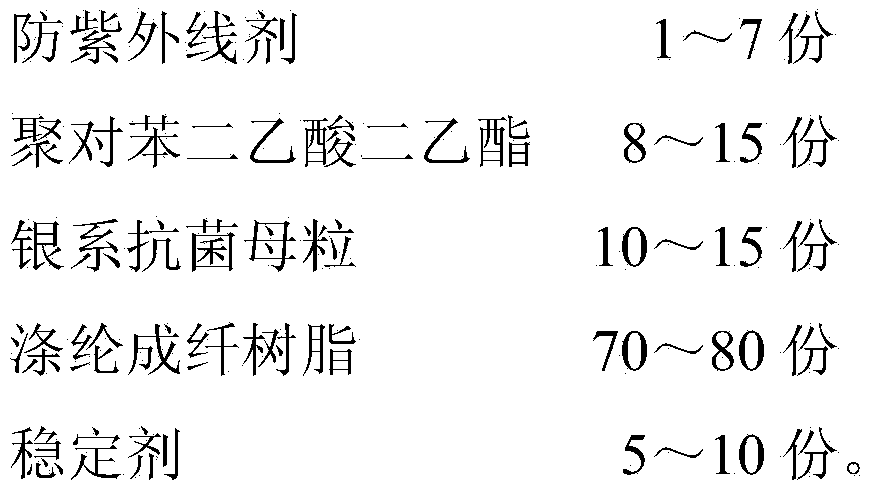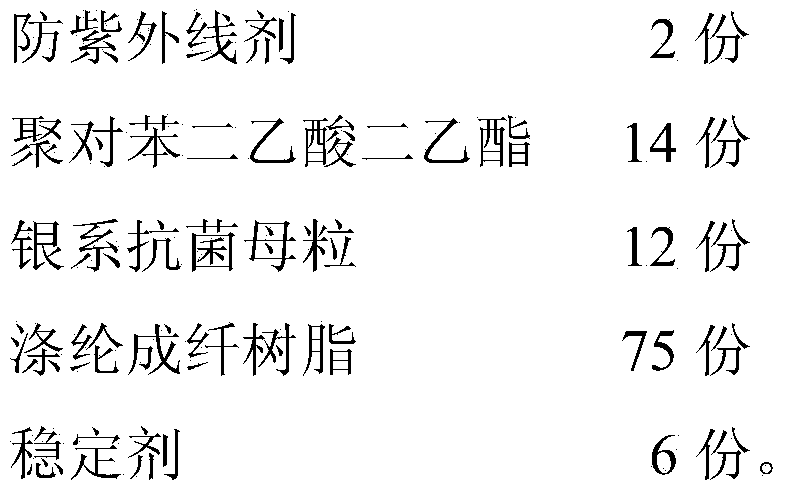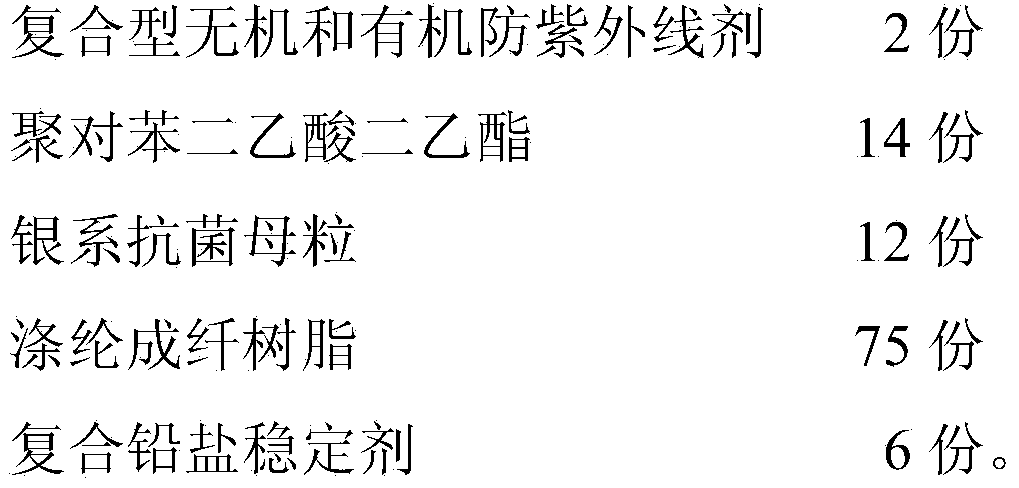Anti-ultraviolet and antibacterial fiber
An anti-ultraviolet and anti-ultraviolet agent technology, applied in the field of anti-ultraviolet and antibacterial fibers, can solve the problems of poor physical properties of fiber products, poor antibacterial effect and anti-ultraviolet effect, and high cost of antibacterial materials, and achieves simple production process, antibacterial effect. Long time and low production cost effect
- Summary
- Abstract
- Description
- Claims
- Application Information
AI Technical Summary
Problems solved by technology
Method used
Image
Examples
Embodiment 1
[0021] An anti-ultraviolet and antibacterial fiber, said anti-ultraviolet and antibacterial fiber is composed of anti-ultraviolet agent, polyethylene terephthalate, silver-based antibacterial masterbatch and polyester fiber-forming resin, each component The parts by weight are as follows:
[0022]
[0023] The above-mentioned composite inorganic and organic anti-ultraviolet agents are TiO containing 10% by weight 2 , 10% UV absorber and 80% polyethylene terephthalate blended.
[0024] The silver-based antibacterial masterbatch is prepared by blending 20% by weight of nano-silver ions and nano-carrier silicon dioxide with 80% by weight of polyethylene terephthalate.
[0025] During preparation, the components can be blended according to conventional methods in this field. The anti-ultraviolet and antibacterial fibers obtained in this example are tested according to conventional methods in this field. The antibacterial effects of Bacillus and Candida albicans reached 98%,...
Embodiment 2
[0027] An anti-ultraviolet and antibacterial fiber, said anti-ultraviolet and antibacterial fiber is composed of anti-ultraviolet agent, polyethylene terephthalate, silver-based antibacterial masterbatch and polyester fiber-forming resin, each component The parts by weight are as follows:
[0028]
[0029] The above-mentioned composite inorganic and organic anti-ultraviolet agents are TiO containing 10% by weight 2 , 10% UV absorber and 80% polyethylene terephthalate blended.
[0030] The silver-based antibacterial masterbatch is prepared by blending 20% by weight of nano-silver ions and nano-carrier silicon dioxide with 80% by weight of polyethylene terephthalate.
[0031] During preparation, the components can be blended according to conventional methods in this field. The anti-ultraviolet and antibacterial fibers obtained in this example are tested according to conventional methods in this field. The antibacterial effects of Bacillus and Candida albicans reached 93%,...
Embodiment 3
[0033] An anti-ultraviolet and antibacterial fiber, said anti-ultraviolet and antibacterial fiber is composed of anti-ultraviolet agent, polyethylene terephthalate, silver-based antibacterial masterbatch and polyester fiber-forming resin, each component The parts by weight are as follows:
[0034]
[0035] The above-mentioned composite inorganic and organic anti-ultraviolet agents are TiO containing 10% by weight 2 , 10% UV absorber and 80% polyethylene terephthalate blended.
[0036] The silver-based antibacterial masterbatch is prepared by blending 20% by weight of nano-silver ions and nano-carrier silicon dioxide with 80% by weight of polyethylene terephthalate.
[0037] During preparation, the components can be blended according to conventional methods in this field. The anti-ultraviolet and antibacterial fibers obtained in this example are tested according to conventional methods in this field. The antibacterial effects of Bacillus and Candida albicans reached 96%,...
PUM
| Property | Measurement | Unit |
|---|---|---|
| transmittivity | aaaaa | aaaaa |
Abstract
Description
Claims
Application Information
 Login to View More
Login to View More - R&D
- Intellectual Property
- Life Sciences
- Materials
- Tech Scout
- Unparalleled Data Quality
- Higher Quality Content
- 60% Fewer Hallucinations
Browse by: Latest US Patents, China's latest patents, Technical Efficacy Thesaurus, Application Domain, Technology Topic, Popular Technical Reports.
© 2025 PatSnap. All rights reserved.Legal|Privacy policy|Modern Slavery Act Transparency Statement|Sitemap|About US| Contact US: help@patsnap.com



